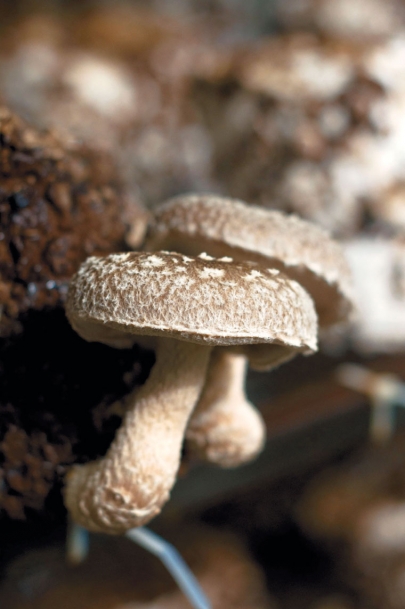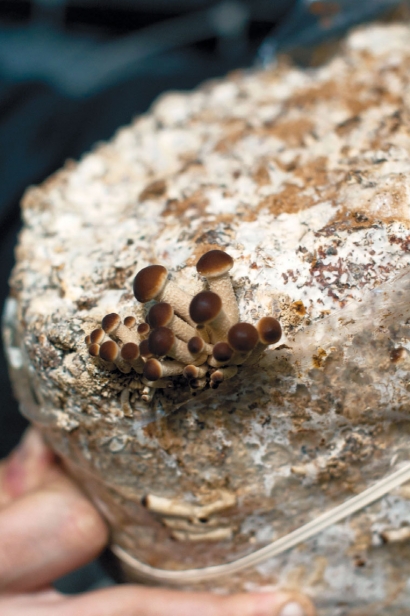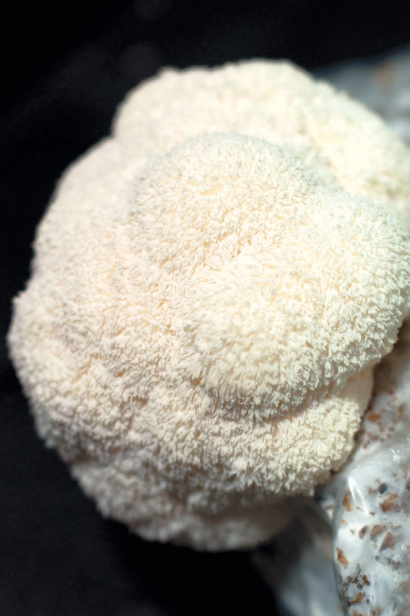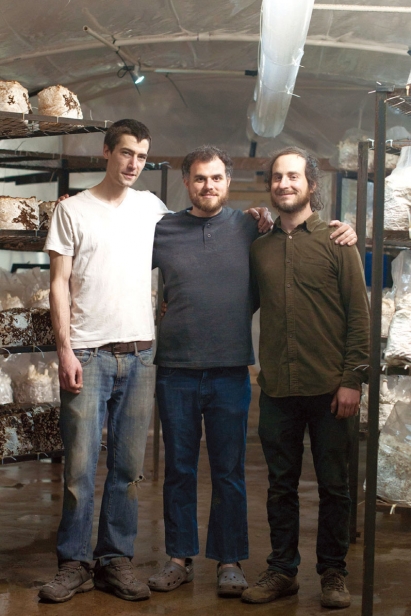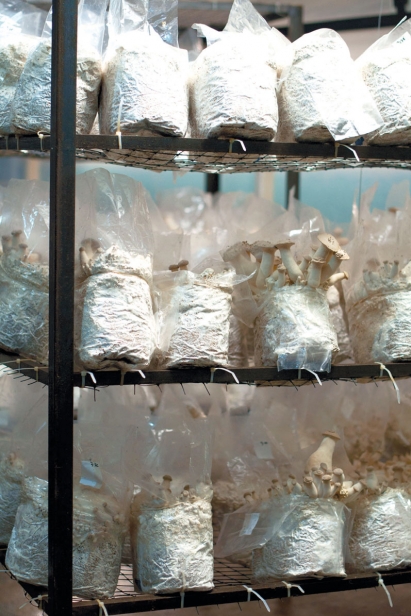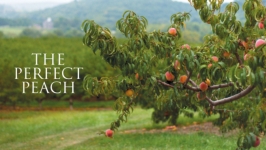A Mushroom Grows in Philly
Mycopolitan Mushroom Company turns the basement of an auto-parts factory into a thriving farm
The first time I met Tyler Case, a monster pothole had just popped my front left tire, and he pulled over in his pickup to help me. He looked just how an urban mushroom grower should look. Young and bright-eyed. Slightly unkempt. And he was chatty verging on verbose when talking fungi.
“So it all starts with substrate preparation,” or the mushroom food, explains the 30-year-old, later. We’re in the warehouse of Mycopolitan Mushroom Company, the burgeoning mushroom-growing business Case cofounded with pals Brian Versek and Dave Novak. I’m on site to see the two-year-old farm, the first of its kind in Philadelphia, housed in the basement of an old auto-parts factory in Juniata Park.
The company, which right now produces between 80 and 200 pounds of mushrooms a week, recently started selling to local restaurants. They seem on the verge of breaking through: “Once we’re familiar with the trials of every season, I think we should be able to hit 250 pounds a week for about three-quarters of the year. We’re not there yet,” Case says, “but we have a lot of open space in the warehouse that we’ll grow into when the time is right. Maybe next winter.”
The Origin Story
Mycopolitan’s backstory sounds familiar yet also entirely one of a kind. Case has always loved mushrooms, to the point of becoming slightly obsessed: He started home-growing them, reading online message boards to try to mimic what others did successfully and avoid their failures. He even attended a seminar led by Paul Stamets, a mycologist and one of the biggest names in the field, “mainly just to hang out with him,” Case says.
But mushrooms weren’t yet his livelihood. For his day job, he conducted research in a psychology lab, with Brian Versek as his coworker. At first, Versek regarded Case’s passion for ’shrooms as a quirk, but then the pair went foraging. “It was a new and exciting and kind of hidden and mysterious world, very rich with impassioned people,” Versek explains by phone. “It slowly seemed less weird and more logical.”
So logical, in fact, that the duo—aided by financial backing from Dave Novak, a longtime friend of Case’s who believed in the farm’s mission—started Mycopolitan with a dozen or so handmade shelving units and a rented 10,000-square-foot basement owned by Common Market, a Philadelphia nonprofit that distributes food from producers in the community. Mycopolitan is part of the Philly Good Food Lab that Common Market established as a collaborative space for local food and drink operations.
“We had a huge cement basement and Mycopolitan came and said they grow mushrooms. They did all of the build-out. It looks awesome,” Hannah Skowronski of Common Market told me. “This is what the Good Food Lab does. We have space and are waiting for the minds to figure out what to do with it.”
The Basement
Walking into the Mycopolitan farm is like descending into the Earth’s depths. It’s dark and damp, and the further you go down the stairs the more you notice a distinctive smell. It’s not a bad smell but something musky, mossy, mushroomy. The farm is also really loud, with a constant hum from the humidification system that slowly fades into the background as your ears get used to it.
The subterranean scene is the opposite of what the word “farm” typically conjures. Despite the literal coldness of the basement, Versek and Case’s farm exudes a warmth and happiness—helped along by the energy of Dan Howling, the company’s only other employee.
On the day I visit, he’s prepping a local rye grain to which he adds gypsum and limestone, a Mycopolitan recipe for the mixture in which the mushrooms will eventually grow. He’s precise, shoveling it into special plastic bags that can withstand 260-degree heat and weighing each one, hitting exactly six pounds. “This is literally where I spend half my day,” Howling says. “This is my gnome corner.”
The basement does feel mystical, the grow room in particular. Everything is handmade. A plastic-covered structure houses shelves filled with a rainbow of browns and whites and reds: Burnt-sienna blocks sprout beige, tan and off-white flora. Some mushrooms pop through the top of the block, others from the bottom, all in varying stages of the weeks-long production operation.
Mushrooms take anywhere from a couple of weeks to a couple of months to grow. “The principles of mushroom cultivation are different than plant cultivation, but relatively simple when you figure out the life cycle,” Versek says.
At its most basic, the process goes: “Substrate, inoculation with spawn, incubation period, then the mushrooms grow,” Case explains. (Despite having zero academic training, Case talks about the fungi like a scientist immersed in the field for years.) Mycelium, the organism that actually produces the mushrooms, gets introduced into the substrate where, in an incubator, it multiplies.
“We open those bags once they’re fully colonized,” Case explains, “and we move that into our grow room, and that’s where the mushrooms grow.” They harvest fungi from each block twice, then send what they call spent substrate to nearby Heritage Farm on Monument Road. “Basically it just becomes worm food, soil for plants,” Case says.
A Feast of Mushrooms
The end product for Mycopolitan, on the other hand, is pure, delicious human food, specifically king trumpet, pom pom, nameko, oyster, pioppino, and shiitake mushrooms. “Our basement is kind of dictating, to some degree, which varieties we do,” Versek says. “We’re trying not to expend a lot of energy to heat or cool the space.”
The surroundings act like natural insulation, Case adds. “Being in a basement, we are mostly underground. The floor and the walls are in contact with the earth that is close to that temperature range [of 55° to 60°, best for mushrooms to grow], so we’re using that as a thermal sink. In January, there’s still some residual heat in there from summer.”
During the colder months of the year, the growers focused on king trumpets, also called king oyster, plus pom poms, also called lion’s mane or bear’s tooth. “There are, like, 15 different names for every mushroom,” Versek says. They’ve also experimented with shiitake. During the spring and fall, most varieties are fair game.
The summer is a different story. Growing will likely slow because of the heat—mushrooms don’t do well in temperatures above 80 degrees—but given that this is the farm’s first full summer of production, it’s still a bit of a guessing game. “The plan is to try out a number of warm-weather-tolerant strains,” Versek says, varieties like pink and gold oyster mushrooms and maybe pioppinos. For both sustainability and financial reasons, Mycopolitan doesn’t plan to air-condition the farm, so as Versek puts it, the farmers are at the weather’s mercy. In some ways, that makes both men even more passionate about the mushrooms they grow, especially about eating them.
To hear Versek and Case describe how to cook them, they all sound delicious. King trumpets—which look almost cartoonish, a real-life, elongated version of the mushroom from Super Mario Brothers, and Mycopolitan’s current bread and butter—can be sliced thin or thick, minced, used like pasta or scallops or as a substitute for bacon. “What chefs are mainly after is the stem because it’s super firm, it’s super big, you can chop it up any number of ways,” says Case.
Pom poms look similar to the eponymous implements cheerleaders wave around, only miniature. “If you can imagine a frozen waterfall,” Versek explains. “It has lots of teeth and spines. It’s a furry sort of guy.” The farmers each separately compared this mushroom’s flavor and texture to crab, and both have food analogies for many other varieties.
“People call it the pork of the mushroom world,” Versek says of pioppino.
“They’re probably the nuttiest mushroom I’ve ever eaten. They taste like straight cashews,” Case says about nameko. He also recommends using them in soup, to thicken up the broth.
A Medicinal Mission
There’s another subfield that interests Versek and Case, too, one that Paul Stamets (the mycologist Case reveres) is an evangelist for: mushrooms as medicine.
In 2008, Stamets gave a TED talk titled “6 Ways Mushrooms Can Save the World” (you can find the video on ted.com) and he wasn’t being facetious in the least. “We share in common the same pathogens,” he said in the talk. “Fungi don’t like to rot from bacteria, and so our best antibiotics come from fungi.”
As part of his research, Stamets began studying the wood conk (also called agarikon) mushroom. “It looks like a beehive. That’s what I try to tell people,” he explained in a segment on NPR’s “Morning Edition.” Stamets, through the Department of Defense’s BioShield program, determined that three strains of these mushrooms were “highly active” against smallpox-related viruses and several flu strains.
It’s an area that the Mycopolitan founders seem keenly interested in—each brought it up to me on different occasions—yet hesitate to fully explore, perhaps because their main focus right now remains turning a profit, or perhaps because discussing something like mushrooms as medicine has the potential to evoke strong, and not so positive, reactions.
“We’re scared of what we don’t know. Paul Stamets understands that in his work as a mycologist,” Versek says, adding that perhaps this direction will be phase two for Mycopolitan following a successful phase one. “When you add those grandiose aspirations to this mushroom farming, it makes you feel good to be doing it, like you’re actually contributing in some way.”
Untapped Potential
For the moment, Mycopolitan’s contribution comes by way of the Philadelphia local-food scene, through supplying mushrooms to area restaurants and through partnerships with some of the city’s other farms. In addition to providing product to establishments like Honest Tom’s Taco Shop, the food-truck-turned-storefront that specializes in a mushroom quesadilla; The Farm and Fisherman; and Kensington Quarters, Mycopolitan is working with Heritage Farm to increase production.
There’s a technique called companion planting in which one crop grows in between rows of other crops, using their shade. In an urban environment, Versek says, space is at a premium, so why not use the area between rows of corn or kale to grow mushrooms? All it would take is mulch that can double as fungi food.
“That’s the thing about mushrooms: There’s always something to get excited about in that world. There’s just so much untapped potential,” he says, adding later, “We’re really just trying to build a place where nutritious food [can] be produced in the city of Philadelphia.” Mycopolitan is starting to make that happen.
As we climb the stairs from the basement, the sudden sunlight makes us take a moment for our eyes to adjust. As quickly as they appeared, the smells and sounds of mushroom production fade, the only evidence of the subterranean farm a big “OPEN” sign across from a piece of printer paper that reads “Mycopolitan is here.”
Mycopolitan, which participates in the Greensgrow CSA, is starting to sell its products at area farmers’ markets, including the N3RD St. Farmers’ Market in Philadelphia, on Church Street between 2nd and 3rd Streets, and the Narberth Farmers Market on North. Narberth Avenue in Narberth.
MYCOPOLITAN MUSHROOM COMPANY
mycopolitan.com


